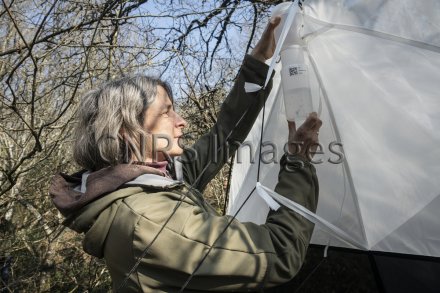Production year
2021

© Jean-Claude MOSCHETTI / ECOBIO / CNRS Images
20210036_0130
Vérification de la bonne installation d'une tente Malaise sur un terrain boisé de la station biologique de Paimpont, en Ille-et-Vilaine, en région Bretagne. Ce piège est assez ouvert, avec une paroi en toile au milieu que les insectes ne peuvent traverser. Ils montent donc au travers d'un trou pour être piégés et recueillis dans une bouteille contenant de l'éthanol. Des prélèvements d'insectes vont être effectués une fois par semaine pendant 6 ans, dans le cadre du projet ERC Synergy Lifeplan. Les insectes seront envoyés à Guelph au Canada au "Centre of Biodiversity Genomics" (CBG), pour leur identification. L'objectif de ce projet est d'échantillonner la biodiversité dans 120 stations de terrain dans le monde entier par différents moyens : tentes Malaise, caméras, enregistreurs audio, échantillonnage de spores et de petits ADN dans l'air (avec un cyclone sampler). Du matériel a été distribué aux 120 stations qui participent à ce projet qui a débuté en octobre 2020.
The use of media visible on the CNRS Images Platform can be granted on request. Any reproduction or representation is forbidden without prior authorization from CNRS Images (except for resources under Creative Commons license).
No modification of an image may be made without the prior consent of CNRS Images.
No use of an image for advertising purposes or distribution to a third party may be made without the prior agreement of CNRS Images.
For more information, please consult our general conditions
2021
Our work is guided by the way scientists question the world around them and we translate their research into images to help people to understand the world better and to awaken their curiosity and wonderment.